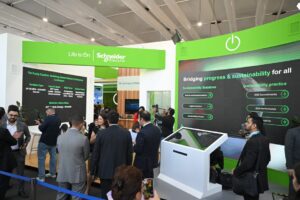Schneider Electric recently announced the global winners of its inaugural Sustainability Impact Awards for 2023, highlighting the success of six global partners. A total of 241 submissions were received for the awards, which were split into two categories: ‘Impact to My Company’ and ‘Impact to My Customers’.

The volume of submissions was impressive, as were the stories of the six winners, but what really stood out was the growing value of the natural crossover that is occurring between sustainability and business efficiency gains.
In an uncertain macroeconomic environment, the ability of partners to fuse sustainability and efficiency narratives together can create compelling value propositions for customers. It becomes easier to justify an investment that potentially advances an organization towards goals on multiple fronts, such as enhancing sustainability credentials and reducing operating costs.
Put simply, the propensity for customers to invest in decarbonization and sustainability initiatives grows in proportion to the resulting business efficiencies that are created.
Catalyzing sustainability momentum with efficiency gains
This is something that all partners at every stage of the customer lifecycle should consider carefully in terms of their approach, engagement, and interaction with both existing and prospective customers. Linking multiple narratives together and positioning the benefits correctly in front of the appropriate stakeholders within a customer organization is a high-value skill.
While the Sustainability Impact Awards had a clear emphasis on partners that successfully decarbonized their own operations, or helped customers achieve their decarbonization goals, it is worth highlighting the criteria that each submission was assessed on.
Submissions were evaluated on how successful their implementation of innovations, products, and digital solutions was in, ‘electrifying operations, reducing energy supply, increasing operational efficiency, and embracing circularity across the value chain.’
Reduction in energy supply and increased operational efficiency can be anchored to clear financial metrics that provide justification for investment and a path to value realization for customer organizations.
What we are now seeing is a combination of factors working together to encourage partners to increase their focus on decarbonization and sustainability. It is not one factor in isolation and there are variables in terms of geography, regulatory environment, and industry vertical that play a role in how fast customers are moving.
Partners have an opportunity to differentiate their value proposition through their sustainability credentials. Customers see sustainability as an enabler of cost reduction and energy efficiency, but also to improve their brand and business value. Once again, this is multiple narratives and benefits weaving together to form a unified value proposition.
Sustainability and decarbonization is not a standalone point solution for a customer, it is a destination and a long-term goal, and this is something all partners need to consider — especially in the context of the Schneider Electric partner ecosystem.
Partner ecosystem drives sustainability momentum
Different partners will interact with the same end-user organization at different points in that customer’s journey. If those partners all have a similar vision, mindset, and approach in relation to sustainability, it creates more confidence for the customer to engage.
This is why it is important for all partners to understand how they fit into the customer journey and how working together and collaborating within the wider Schneider Electric partner ecosystem is an important part of this process.
Partners can utilize the wider partner ecosystem to access complementary skills and expertise to boost their sustainability credentials. Partners that decarbonize their own operations are better positioned to assist customers in their decarbonization journey and work with them toward meeting their goals.
Partners must show flexibility to ensure that their sustainability credentials map onto customer needs, customer requirements, and align with their medium to long-term commitments related to decarbonization.
There is a growing opportunity for the Schneider Electric partner ecosystem to work together to create, deliver and optimize sustainability solutions for customers — and this also has the potential to open new business opportunities and create long-term service-based relationships.
The inaugural Sustainability Impact Awards for 2023 provided a glimpse of the progress and achievements that have already been accomplished within the Schneider Electric partner ecosystem. The growing symbiosis between achieving efficiency gains and meeting sustainability goals has the potential to further accelerate that progress in the years ahead.
About the author

Stuart Wilson – IDC Research Director, European Partnering Ecosystems
Based in London, Stuart has covered global business-to-business and business-to-consumer channels for 20-plus years in a wide variety of research, editorial, and event-based roles. Stuart focuses on the evolution of go-to-market models and the wider impact on channel ecosystems, exploring how current and future trends will impact the vendor, distributor, and channel partner landscape.



